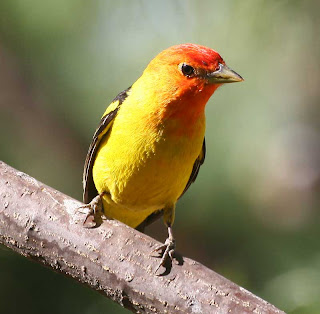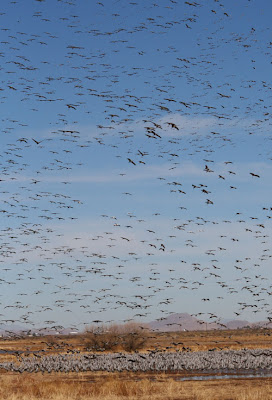On this hot, dry, and windy June afternoon, the chickens were restless. Despite my efforts to make them more comfortable—watering patches of dirt for bathing, setting out a bowl of iced apple juice—they wanted more relief and knew where to find it. One by one they hopped up onto the porch and stood by the door, looking longingly through the glass.
It was uncomfortable for me, too, so I went back inside, locked the dog in the bedroom, and invited the girls into the house. They ate and drank from Sibella's bowls, scavenged the kitchen floor for crumbs, and visited me in the study as I worked at the computer. Pearl was muttering to herself a lot and couldn't seem to get comfortable on my lap. Only when I noticed her trying to mold a nest out of the folds of a serape draped over the dog's chair did I realize that she had an egg to lay and needed to return to the coop.
With bowls of frozen peas and corn as bait (lightly thawed as a cool treat), I lured the girls out the door into dim orange light filtering through a dense column of smoke. Fragments that were once grass leaves, now carbon ghosts, spiraled down to land on the deck. The plume from the Monument Fire, 22 miles to the west on the southern end of the Huachuca Mountains, had been drifting across our neighborhood since yesterday afternoon. In less than an hour it had increased so dramatically in breadth and density that it sent a jolt of fear through me. I hurriedly shooed the chickens into their run, grabbed my car keys, and headed west to see how far the fire had spread.
 |
| The Monument Fire in the Huachuca Mountains, as seen from near Bisbee |
It was an eerie scene. Smoke billowed up from a broad front on the southeastern corner of the mountains, reducing the sun to a glaring red eye. From my distant vantage point I could see no flames or firefighting activities, but it was clear that the fire was burning the oak woodland and pine-oak forest homes of many of our favorite birds and approaching the houses of people we know.
The order came down this afternoon that residents of the southeastern canyons of the Huachucas would need to evacuate. Human residents will take refuge in the homes of friends and relatives, motels, bed & breakfasts, etc. Livestock will ride out the fire at nearby ranches. Untold numbers of wild creatures will find no sanctuary while the fire rages. Many will not survive, and many that do will have nowhere to return to once it's out.
Residents of the Chiricahua and Huachuca mountains have reported wild refugees fleeing the fires. Bird activity around the town of Portal in Cave Creek Canyon has been very high, and a colleague who lives in the Huachuca foothills reported seeing a desperate-looking Black Bear at his backyard water feature as he was preparing to evacuate.
 |
| A hungry Western Tanager |
We live too far from the Huachucas or Chiricahuas to expect fire refugees, which is a small blessing. We already have our share of drought refugees, birds and other wildlife desperate for food and water.
This spring, unprecedented numbers of Wilson's Warblers, Western Tanagers, and Black-headed Grosbeaks swamped feeding stations and concentrated along the San Pedro River seeking what little water and food were available in this parched landscape. In our yard, Mule Deer stripped a young mulberry tree of most of its leaves, and Javelinas (a.k.a. Collared Peccaries) ate all the new growth from our few prickly pear cacti that survived the brutal February cold snap. Rock Squirrels were eating all the seed, fruit, and peanut butter dough we put out for the birds, so we began live-trapping them for deportation well beyond the edge of town. We've relocated eleven so far. Cages, netting, and vigilance are the only reasons any of our vegetables have made it this far.
The drought and fires extend well into Mexico, which may be responsible for the appearance of a number of local and regional rarities: a Yellow Grosbeak in Ash Canyon, a Berylline Hummingbird on the San Pedro River, Lucifer Hummingbirds at several unusual locations, and various eastern "vagrants" at others (possibly stranded, unable to find enough food to fuel the next legs of their migrations).
Drought is such a slow-moving disaster that it doesn't make headlines until fires break out. Climate change, too, creeps so slowly that Big Fossil's lobbyists and the politicians they own have had plenty of time to quibble, bluster, and stall, effectively thwarting efforts to avert this disaster in the making. It beggars belief that anyone can continue to scoff in a year of record-breaking storms, floods, droughts, and fires, yet some do.
The past year has fulfilled climatologists' predictions of greater extremes, including wet summers in the Southwest followed by rainless winters and springs. This is a perfect recipe for devastating forest fires. Summer rainfall stimulates abundant growth of grasses, annuals, and shrubs that, once dried, provide ideal fuel, and winter/spring drought creates ideal conditions for catastrophic fires.
It's vitally important to understand that fire is an essential element in many western forests. Southwestern forests in particular need periodic fires to recycle the nutrients in leaf litter and other debris that doesn't decompose in the dry climate. Keeping fire out of these forests is a recipe for disaster, yet that's exactly what we've been doing (first incidentally, then actively) for more than a century.
That said, the fires currently burning are not the kind we need. Natural fires are sparked by lightning from the first dry storms of the summer "monsoon" and usually quickly extinguished by the rains that follow. The current fires are all of human origin, ignited weeks ahead of the rains during our driest, hottest, and windiest time of year. This means weeks of valiant efforts to manage the fire, keep it away from structures and ecological jewels, and "encourage" it to burn in a way most conducive to forest hygiene. Weeks of flames sweeping and/or creeping through our "sky islands."
This is all I can bear to write tonight, but there's more of the story to tell. I'm going to go watch the moon rise and think about Part 2.
Update: I just heard from a friend that the fire jumped Hwy 92 late this afternoon, and that a number of structures have already been lost.




















